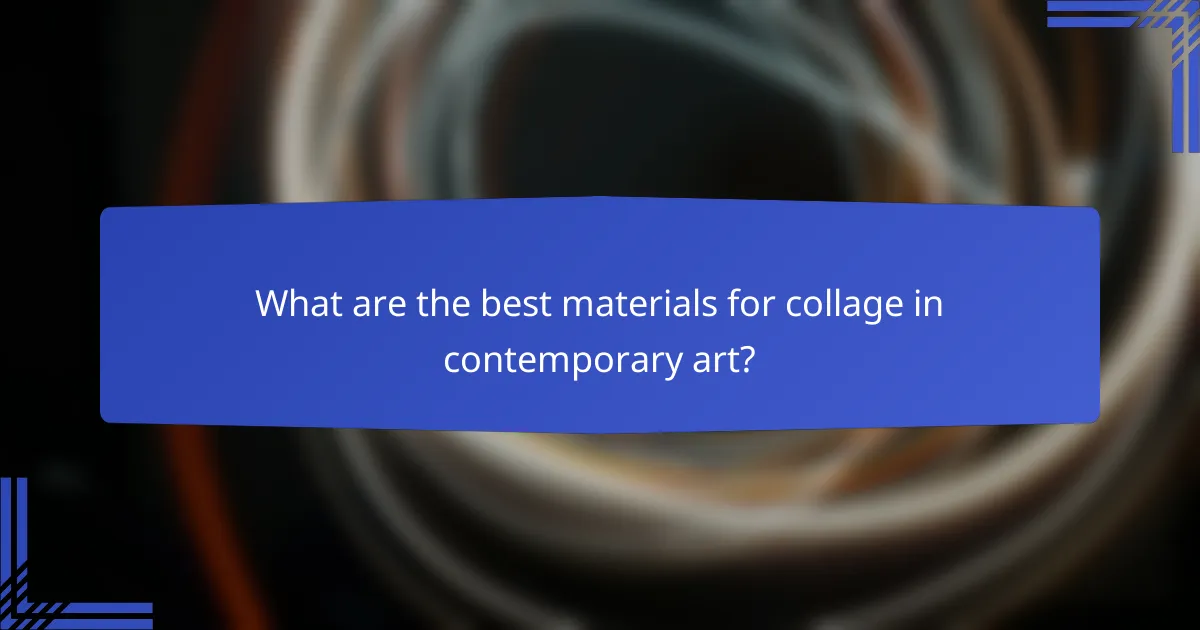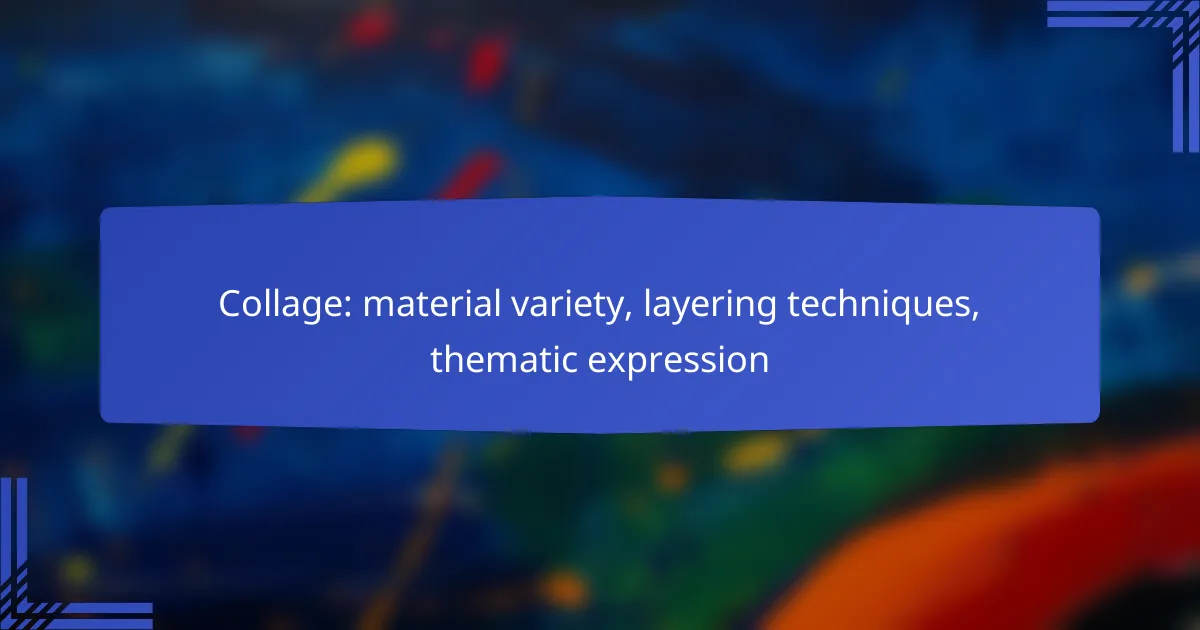Collage is a dynamic art form that thrives on material variety and innovative layering techniques. By incorporating diverse elements such as paper, fabric, and found objects, artists can create rich, textured compositions that explore complex themes. This versatility allows for profound thematic expression, inviting viewers to engage with the layered narratives and messages within each piece.

What are the best materials for collage in contemporary art?
The best materials for collage in contemporary art include a diverse range of items that can enhance texture, color, and thematic expression. Artists often use paper, fabric, found objects, digital elements, and recycled materials to create unique compositions that convey their intended message.
Paper types
Paper is a fundamental material in collage, offering various textures and weights. Common types include cardstock, tissue paper, and magazine clippings, each providing different visual effects. Consider using heavier papers for a sturdy base and lighter papers for layering and delicate details.
Experimenting with different finishes, such as glossy or matte, can also impact the overall look of your collage. Mixing various paper types can create depth and interest, allowing for a more dynamic composition.
Fabric options
Fabric adds a tactile element to collages, introducing softness and warmth. Common choices include cotton, silk, and burlap, which can be cut into shapes or used as backgrounds. The texture of fabric can enhance the visual appeal and create contrast with paper elements.
When selecting fabric, consider its weight and how it interacts with other materials. Lighter fabrics may require adhesive that is suitable for textiles, while heavier fabrics can provide a strong foundation for layered pieces.
Found objects
Incorporating found objects can add a three-dimensional aspect to your collage. Items like buttons, feathers, or small pieces of wood can serve as focal points or accents. These materials often carry personal significance, enhancing the thematic expression of your work.
Be mindful of the weight and size of found objects, as they can affect the stability of your collage. Use strong adhesives or consider mounting them on a sturdy backing to ensure they remain securely attached.
Digital elements
Digital elements, such as printed images or graphics, can be seamlessly integrated into collages. Using digital tools allows for precise control over color and composition, making it easy to experiment with different layouts before finalizing your piece.
When printing digital images, choose high-quality paper to maintain clarity and vibrancy. Consider using a variety of digital textures to complement traditional materials, creating a hybrid approach that enhances visual interest.
Recycled materials
Recycled materials not only promote sustainability but also add unique character to collages. Items like old newspapers, packaging, or scrap paper can be repurposed to create visually engaging compositions. This approach encourages creativity and resourcefulness.
When using recycled materials, be aware of their condition and how they will adhere to your base. Some materials may require additional treatment, such as flattening or sealing, to ensure they integrate well with other elements in your collage.

How can layering techniques enhance collage artwork?
Layering techniques can significantly enhance collage artwork by adding depth, complexity, and visual interest. By strategically combining various materials and textures, artists can create a more dynamic composition that engages viewers and conveys thematic messages.
Overlapping layers
Overlapping layers involve placing one material over another to create a sense of depth and dimension. This technique can help guide the viewer’s eye through the artwork, emphasizing certain elements while obscuring others. When using overlapping layers, consider the transparency and color of each layer to ensure they complement rather than clash.
A practical tip is to start with larger, more dominant pieces at the back and gradually add smaller, intricate details on top. This approach can create a natural flow and hierarchy within the collage.
Transparent materials
Incorporating transparent materials, such as tissue paper or plastic, allows for unique visual effects and layering possibilities. These materials can soften colors and create intriguing interactions between layers, enhancing the overall composition. When using transparency, experiment with different opacities to achieve the desired effect.
Consider using transparent materials to highlight specific themes or messages in your artwork. For example, layering a transparent image of a flower over a textured background can evoke feelings of fragility and beauty.
Textural contrasts
Textural contrasts play a crucial role in collage artwork by adding tactile interest and visual variety. Combining smooth, rough, soft, and hard materials can create a compelling interplay that draws viewers in. When selecting materials, think about how their textures will interact with one another.
A useful approach is to balance heavier materials, like cardboard or wood, with lighter elements, such as fabric or paper. This contrast not only enhances the visual appeal but also invites touch, making the artwork more engaging.

What themes can be expressed through collage?
Collage is a versatile art form that allows artists to express a wide range of themes by combining various materials and techniques. Through layering and juxtaposition, collages can convey complex messages about society, personal experiences, and cultural identities.
Social commentary
Collage can serve as a powerful medium for social commentary, enabling artists to critique societal issues and provoke thought. By incorporating images from newspapers, magazines, and other media, artists can highlight topics such as inequality, politics, and environmental concerns.
For effective social commentary, consider using contrasting images to emphasize disparities or layering text with visuals to create a narrative. A collage addressing climate change might juxtapose images of nature with industrial scenes, prompting viewers to reflect on the impact of human activity.
Personal narratives
Artists often use collage to tell personal stories, allowing for a unique exploration of identity and experiences. By combining photographs, mementos, and other personal items, collages can capture memories and emotions in a visually engaging way.
When creating a personal narrative collage, select materials that resonate with your experiences. Consider using items like ticket stubs or handwritten notes to add depth. This approach not only personalizes the artwork but also invites viewers to connect with the story being told.
Cultural identity
Collage can effectively express cultural identity by blending symbols, colors, and textures that represent different backgrounds. Artists can celebrate their heritage or comment on the complexities of multiculturalism through their work.
To create a collage reflecting cultural identity, gather materials that represent your culture, such as traditional patterns or iconic imagery. Layering these elements can create a rich tapestry that honors your roots while also inviting dialogue about cultural intersections.

What are the essential tools for creating collages?
The essential tools for creating collages include adhesives, cutting tools, and protective coatings. Each tool plays a crucial role in the collage-making process, influencing the final appearance and durability of the artwork.
Adhesives
Adhesives are vital for securing various materials in a collage. Options include glue sticks, liquid glues, and double-sided tape, each offering different strengths and drying times. For paper collages, a glue stick is often preferred for its ease of use and clean application.
When selecting adhesives, consider the materials you are working with. For heavier items like fabric or wood, a stronger adhesive, such as PVA glue or a hot glue gun, may be necessary. Always test a small area first to ensure compatibility and avoid damage.
Cutting tools
Cutting tools are essential for shaping and trimming materials to fit your collage design. Common options include scissors, craft knives, and paper cutters. Each tool has its advantages; for instance, craft knives provide precision for intricate cuts, while scissors are better for quick, general trimming.
When using cutting tools, ensure you have a cutting mat to protect your work surface. Always cut away from your body and keep blades sharp for clean edges. For safety, especially with children, opt for safety scissors or supervise the use of sharper tools.
Protective coatings
Protective coatings help preserve the integrity of your collage over time. Options like spray varnish, Mod Podge, or acrylic sealers can provide a protective layer against moisture, dust, and UV light. Choose a coating based on the desired finish—matte or glossy—and the materials used in your collage.
Apply protective coatings in a well-ventilated area and follow the manufacturer’s instructions for best results. Be mindful of drying times and layering; applying too thickly can lead to drips or uneven surfaces. Regularly check your collage for signs of wear and reapply coatings as needed to maintain its appearance.

What are the prerequisites for starting collage art?
To begin collage art, you need a few essential supplies and a dedicated workspace. Understanding the materials and setting up an environment conducive to creativity will enhance your collage-making experience.
Basic art supplies
Essential supplies for collage art include various types of paper, scissors, glue, and a cutting mat. You might also want to have magazines, photographs, fabric scraps, and decorative elements like stickers or washi tape at hand.
Consider the quality of your materials; for instance, acid-free glue will help preserve your artwork over time. A variety of textures and colors will enrich your collages, so aim to gather a diverse selection of papers and embellishments.
Workspace setup
Your workspace should be well-lit and organized to facilitate the collage-making process. A sturdy table or desk is ideal, along with easy access to your supplies to minimize interruptions while working.
Ensure that your workspace allows for layering and experimenting with different arrangements. A large cutting mat can protect your surfaces and provide a designated area for cutting and assembling your pieces.

How does collage differ from other art forms?
Collage is distinct from other art forms primarily due to its use of diverse materials and layering techniques. Unlike traditional painting or sculpture, collage incorporates various elements such as paper, fabric, and found objects, allowing for unique thematic expression and visual depth.
Material variety
Collage artists utilize a wide range of materials, which can include photographs, magazine clippings, textiles, and even three-dimensional objects. This variety enables creators to explore different textures and visual effects, making each piece unique. For example, combining glossy magazine images with rough fabric can create a striking contrast that enhances the overall composition.
Layering techniques
Layering is a fundamental technique in collage, where artists build depth and complexity by overlapping materials. This can involve arranging items in a way that creates a sense of space or narrative. Techniques such as transparency, where lighter materials allow underlying layers to show through, can add intrigue and dimension to the artwork.
Thematic expression
Collage allows for rich thematic expression, as artists can juxtapose disparate elements to convey complex ideas or emotions. For instance, a collage might combine images of nature with urban scenes to comment on environmental issues. The ability to mix various media encourages a dialogue between the elements, inviting viewers to interpret the work in multiple ways.
